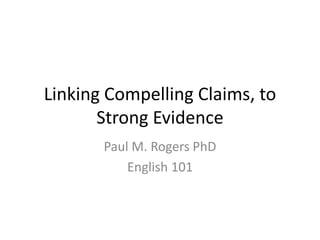Claimsandevidence
- 1. Linking Compelling Claims, to Strong EvidencePaul M. Rogers PhDEnglish 101
- 2. Persuasive Communication Rhetoric: The ability in any particular case to see all the available means of persuasion (Aristotle, The Rhetoric). Being persuasive is an abilityIt can be developed through study and practiceWill give you more options to accomplish your communication goalsThere are multiple means of persuasionBut, first be clear about your purposeKnow your audienceUse ethos, logos, and pathos
- 3. Three Means of Persuasion: Ethos, Logos, and PathosIt Logos(Text/Message/Medium)PurposeKairos(Urgent and Non-Trivial)I Ethos (Writer/Speaker)You Pathos (Audience(s))
- 4. In College Writing You Must Develop Your Logical Argumentation AbilitiesLOGOS = LOGICAL ARGUMENTATIONPurposeKairos(Urgent and Non-Trivial)I Ethos (Writer)You Pathos (Audience(s))
- 5. Standard HalogenXenonLet’s look at some data: Which of the images shows more light on the road and surrounding area?SilverStar Ultra TM
- 6. Standard HalogenXenonHalogen HeadlightSilverStar Ultra TMXenon Headlight
- 7. Standard HalogenXenonXenon headlights illuminate signs better than halogen headlights doHalogen HeadlightSilverStar Ultra TMXenon Headlight[Sylvania, 2008 ]
- 8. My Papa's Waltz by Theodore Roethke The whiskey on your breathCould make a small boy dizzy;But I hung on like death:Such waltzing was not easy.We romped until the pansSlid from the kitchen shelf;My mother's countenanceCould not unfrown itself. The hand that held my wristWas battered on one knuckle;At every step you missedMy right ear scraped a buckle. You beat time on my headWith a palm caked hard by dirt,Then waltzed me off to bedStill clinging to your shirt.
- 9. 4 Steps Write a brief one or two sentence summary of this poemMake an assertion: What is this poem about?What evidence do you have to back up your claim? What is your strongest evidence?Link your claims and evidence together in a single statement
- 12. Is Queenie Lying?Your thesis is the response to this question.Identify all of the evidence you can find to support your claimRank your evidence from strongest to weakest
- 13. Aristotle’s Rhetoric provides a solid foundation for practicing, learning, and teaching communication, including writingLOGICAL ARGUMENTATIONPurposeKairos(Urgent and Non-Trivial)I Ethos (Speaker)You Pathos (Audience)
- 15. A Process for Creating Compelling ArgumentsStart with data and data analysisForm your questionsMake a claim or a thesis that is worth arguingMake explicit the connections between the data and the claims
- 16. Qualifications/Hedge WordsPossibleConceivable CouldMay Might PerhapsAlmost certainVirtually certain All but certain Highly probable Highly likely Odds [or chances] overwhelmingProbable Likely We believe We estimate50-50 chances About even Chances a little better [or less] than even Improbable UnlikelyProbably notWe believe that . . . not We estimate that . . . not We doubt, doubtfulAlmost certainlyVirtually impossible Almost impossible Some slight chance Highly doubtful
- 17. Standard HalogenXenonArguments that links claims and evidence are more persuasive than those that don’t!Halogen HeadlightSilverStar Ultra TMXenon Headlight[Sylvania, 2008 ]
- 18. Exchange your change maker paper with a partnerTreat the paper as data Is this individual making a significant and positive impact in the world?Can you make a case based on the evidence in the paper.Using their paper as data, make an argument that links together your claims and their most compelling evidence.
- 19. Three Means of Persuasion: Ethos, Logos, and PathosIt Logos(Text)PurposeKairos(Urgent and Non-Trivial)I Ethos (Speaker)You Pathos (Audience)
- 20. PurposeINFORM: What do I want my audience to know?ENTERTAIN: What do I want my audience to feel?PERSUADE: What do I want my audience to do?
- 21. Writing as discoveryOur ideas change as we writeWe gain content knowledgeOur purpose can become clearer as we write and reviseMultiple purposes in one piece of writing, but a dominant one will probably emerge
- 23. Ethos = credibilityWhat counts as credibility differs among groups of people O'Keefe (1990) defined credibility as "judgments made by a perceiver concerning the believability of a communicator" In other words “credibility is in the eye of the beholder”
- 30. The two most important elements in establishing credibility are expertise and trustworthiness
- 31. Credibility is subject to change over time
- 35. What will compromise your credibility in the short and long term?
- 36. A single spelling error on a resume of cover letter could seriously undermine your competitiveness in applying for an internship or job.
- 37. Two kinds of credibility
- 39. Extrinsic: what people know about you before they read your work or hear you speak
- 40. Intrinsic: what we do within a communication setting through our actions.
- 41. Putting ethos to work in your writingKnow your materialCite evidence (Reinard, J.C. (1988) Human Communication Research, 15,3-59).Share your interest, experience, and expertiseHave your reader’s best interest in mindIdentify similarities with your readerIf you lack extrinsic credibility increase your reader’s involvement with the topic, which will help focus them on the topic more than the messenger (Petty and Cacioppa, 1986).
Editor's Notes
- What happened?Can we believe Queenie?PictureHere testimonyAutopsy report







![Standard HalogenXenonXenon headlights illuminate signs better than halogen headlights doHalogen HeadlightSilverStar Ultra TMXenon Headlight[Sylvania, 2008 ]](https://image.slidesharecdn.com/claimsandevidence-110906105005-phpapp01/85/Claimsandevidence-7-320.jpg)








![Qualifications/Hedge WordsPossibleConceivable CouldMay Might PerhapsAlmost certainVirtually certain All but certain Highly probable Highly likely Odds [or chances] overwhelmingProbable Likely We believe We estimate50-50 chances About even Chances a little better [or less] than even Improbable UnlikelyProbably notWe believe that . . . not We estimate that . . . not We doubt, doubtfulAlmost certainlyVirtually impossible Almost impossible Some slight chance Highly doubtful](https://image.slidesharecdn.com/claimsandevidence-110906105005-phpapp01/85/Claimsandevidence-16-320.jpg)
![Standard HalogenXenonArguments that links claims and evidence are more persuasive than those that don’t!Halogen HeadlightSilverStar Ultra TMXenon Headlight[Sylvania, 2008 ]](https://image.slidesharecdn.com/claimsandevidence-110906105005-phpapp01/85/Claimsandevidence-17-320.jpg)























